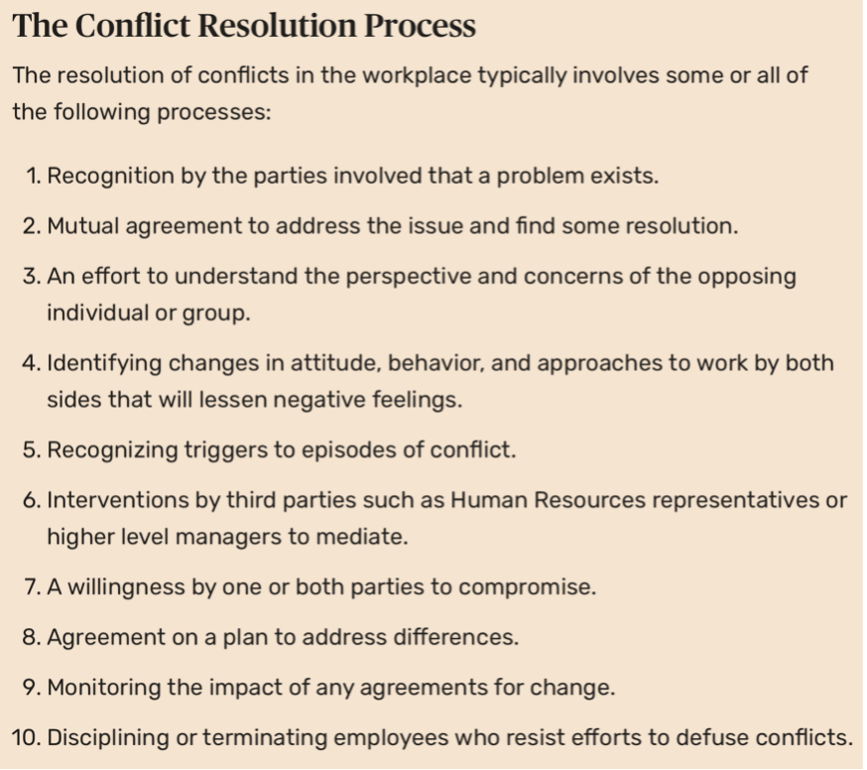Conflict resolution has two parts:
- Conflict management - deals with reducing strong emotions and achieving a mutual clarification and understanding of differences.
- Negotiation - finds an acceptable outcome to everyone through problem solving and creativity.
The key to a successful outcome is a positive frame to work within in of :
- Respect.
- Rapport.
- Resourcefulness.
- Constructive attitude.
The Chartered Institute of Personnel and Development (CIPD) is a professional body of HR experts trying to set better standards for working lives. They have produced a useful guide for managers in how to deal with conflict.
Download and/or read the full PDF of the guide here.
There are many other resources online describing the steps in the process of constructive conflict resolution. Below are two examples, but you should research and read other versions of the process.

(Abdalla, 2019)

(Chartered Management Institute, 2013), (Managing Conflict, n.d.)
Exercise 27
Using one of the above processes, or one you have researched online, think of how to apply it to Chef John’s situation in Scenario A. Imagine you are the owner or general manager of the restaurant in the scenario – what would you do to try to resolve this conflict in a constructive way? You can use your work to help you in your planning for Question 2 of Scenario A of the assessment.
Self-Directed Learning
Sometimes it is impossible to resolve a conflict at work. Maybe a problem has been avoided or the attempts to find a solution have not been successful.
What reasons might lead to a conflict not being resolved? If a serious conflict in the workplace is not resolved, what might happen? Think about the staff (those directly and indirectly involved) and also consider the impact on the business.
What third party intervention is available to you in New Zealand if your workplace conflict cannot be resolved internally.
Edward de Bono’s Six Thinking Hats is a technique that allows a team to investigate an issue in a clear, conflict-free way. It assists in preventing any confrontation because everyone’s perspective is valid.
Each hat has a different colour and represents a different type of thinking.
Investigate the Six Thinking Hat page on BBC Bitesize which describes each hat and how it is used in a discussion/negotiation.
Exercise 28
Scenario
The inner city restaurant where Ruby works as a kitchen hand has struggled during Covid restrictions. Her manager has announced that all staff will have their hours reduced by 20% effective immediately. She only just covers her bills during a 50 hour week and can’t imagine how she will get by on any less.
- Practice using the Six Thinking Hats technique to examine all angles of Ruby’s situation. This link provides sample questions for each thinking hat to assist you.
- Discuss your responses with a partner and choose the best response for each ‘Hat’.
Self-Directed Learning
Watch Kwame Christian discuss the approaches we can take when conflict arises. Summarise his message and any changes you plan to make after watching his presentation.
One of the most effective strategies for preventing destructive conflict is to encourage open communication in a safe environment. Let’s look at some of the ways we can foster good communication.
Non-Verbal Communication

Nonverbal communication, or body language, “is a type of communication in which physical behaviours, as opposed to words, are used to express or convey the information. Such behaviour includes facial expressions, body posture, gestures, eye movement, touch and the use of space.” (Shirsat, 2022)
In other words, your body language is more important than tone of voice or choice of words when communicating. It comes through most of the time whether you intend to reveal it or not and has been estimated to account for 60-65% of all communication.
(Foley and Gentile, 2010).
Exercise 29
- Find 10 photos or pictures depicting body language. For each example describe the message is being portrayed and whether the body language is positive or negative. e.g., nail biting is an example of negative body language suggesting insecurity or stress.
- Click on this link to view three examples of why body language is important to communication.
- What is the “correct” interpretation?
Remember - you may interpret body language one way, but the gesture may mean something entirely different to someone else. When reading body language this is particularly important to know when there are cultural differences between people.(22 Body Language Communication, 2022)
Self-Directed Learning
Your body language has a major effect on conflict. It can help you stay calm in situations where emotions run high. Learning to hold your face in a neutral and relaxed expression can be a useful skill to develop.
- Identify some nonverbal messages you could practice indicating a willingness to work toward resolution and collaboration.
- What are some nonverbal messages we might (unintentionally) use in times of conflict that adversely affect resolution?
Turn the sound off on the TV or watch in a language you can't understand, and try to follow what is happening based on the non-verbal clues.
How aware are you of your own facial expressions? Ask a friend or family member, or better still video yourself – you may be surprised!

Displaying a willingness to listen can help alleviate conflict. Active listening means fully concentrating on what is being said rather than just passively ‘hearing’ the speaker. Any message a person tries to get across usually has two components: the content of the message and the feeling or attitude underlying this content (Ward, 2022), hence active listening not only means focusing fully on the speaker but also actively showing verbal and non-verbal signs of listening.
Although it is very tempting to charge into a discussion to make ourselves heard and understood, the better strategy is to begin by listening in order to understand the speaker’s perspective on the discussion topic. This allows us to then enter the dialogue with relevant and useful information.
Remember you can still show interest in the person while not necessarily agreeing with her/his point of view.
Exercise 30
- What are some of the barriers to effective listening? (Find at least ten to write about in your journal.)
- Discuss some appropriate listening strategies to overcome these barriers.
Actively listening in a conflict situation
- How easy or difficult is it to listen during a conflict? Why?
- Explain the importance of listening in a conflict situation.
Exercise 31
Work through the following Listening Exercise, keeping a progress log in your journal.
- Think of a specific, regular discussion time that you’re involved in such as a toolbox meeting, coaching session, family dinner etc.
- Visualise yourself attending that meeting with the intention of actively listening first rather than being the first to do the speaking.
- Imagine yourself asking questions to draw out more information, to clarify, and to better understand what you are hearing.
- Keep replaying this scenario in your head until you can easily picture yourself actively listening to the other person.
- Reflect on the following questions:
- How would your relationship with that person(s) change if you regularly listened first?
- How would you change if you regularly listened first?
- How will you initiate your next discussion with that person(s) so they speak first?
- Now put your plan into action!
- Reflect on what did and didn’t work. What changes would you make before your next meeting?
(Ward, 2022)
Share your journal entry with your tutor.
Self-Directed Learning
Listening is not always face-to-face, with many interactions taking place over the telephone, by email or on social media, where you no longer have the benefit of reading the person’s body language.
Research and write a set of Workplace Email Etiquette Rules for your workplace team. These rules should be appropriate for all communications (co-workers, managers, customers, and suppliers).
Discuss as a class, then construct a brief set of Workplace Email Etiquette Rules that could be posted in your workplace.
Part of developing your active listening skills is learning how to provide feedback and in order to do so you must fully understand what is being said. Your own assumptions and beliefs should not be part of the listening process.
Reflect on what is being said by paraphrasing and clarify what is being said by asking questions.
Paraphrasing means stating in your own words, and from your own understanding, what you think someone has said or expressed. It lets the speaker know you are listening while providing an opportunity to check for understanding and clear up any misunderstandings. It also keeps the listener focused on what the speaker is saying.
The focus is on clarifying information rather than reacting to the situation so it has the benefit of calming a volatile situation.
The three ways to paraphrase are: paraphrasing for facts only, paraphrasing for feelings only, and paraphrasing for both facts and feelings.
When paraphrasing, it is important not to be judgmental, whether by body language, tone of voice, or choice of words.
(Strengthening Communication and Problem-Solving Competencies for CNAs, 2010)
WATCH
Watch the following videos to see paraphrasing in action.
Exercise 32
Practice paraphrasing on a family member, friend or co-worker. (Don’t tell them what you are doing however!)
- Choose a conversation topic you know you disagree on – vaccination, favourite rugby team etc.
- For the first part of the conversation communicate as you normally would.
- Now change your communication pattern by paraphrasing what the other person just said.
- How did the conversation dynamic change when you switched to paraphrasing? How did you feel compared to no paraphrasing? How did the other person react? What did you both discover about your thoughts on the issue being discussed?
